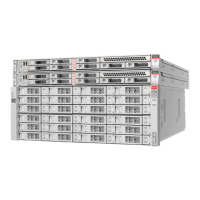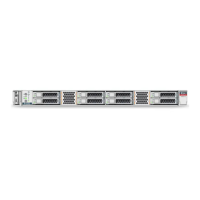Base Module Mounting Rail
Hardware Installation 3-5
Tool Requirement
#2 Phillips screwdriver (not provided).
Install the Base Module Back Rails
The following instructions and supporting illustrations use rack units 32 through 34
for installation of the base module. The back rail is mounted in the middle rack unit (U
33 for this example).
1. Locate the rack unit designation where you will install the back rail (use the rail
installation template as necessary), and allow rack space for library expansion.
2. Position the mounting block so the screw hole is in the second hole (center hole) of
the rack unit.
3. Hold the block in place.
4. Position the back rail so the blade extends to the interior of the rack (see
Figure 3–5).
5. Use one hand to hold the back rail and the mounting block in position.
6. Insert the 8–32 screw into the mounting block hole, and turn the screw several full
turns by hand.
7. Tighten the 8–32 screw with a #2 Phillips screwdriver.
8. Make sure the wide surface of the back rail is plumb with the inside edge of the
rack stile while maintaining an equal gap between the rack stile and the top and
bottom edges of the back rail.
Note: The mounting block has two pins and a threaded hole.
These elements must reside within a single defined U boundary.
Use the scribe marks, notches, or other comparable rack
designations to identify the U boundary. Do not mount the block
with the pins straddling a U boundary.
Note: Mount the base module at a height enabling easy user
access to the front control panel while providing sufficient space for
library expansion below the base module (a 10-module library
spans 21U and a 15-module library spans 31U).
Note: The pins and screw hole must be within the boundaries of a
single rack unit. Pay attention to the rack unit boundary identifiers
(such as rack stile scribe lines or notches).
Note: If this is a square hole installation, make sure the face of the
mounting block is flush with the rack rail. In round hole racks,
make sure the pins are within a rack unit and extend an equal
distance (see Figure 3–5).
